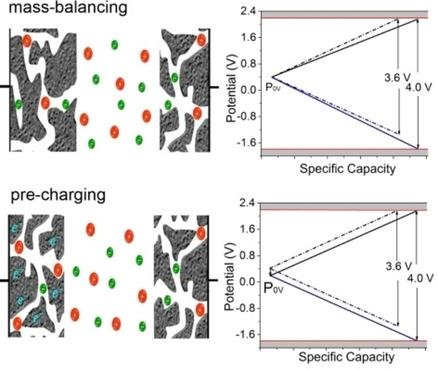当前位置:
X-MOL 学术
›
ChemElectroChem
›
论文详情
Our official English website, www.x-mol.net, welcomes your
feedback! (Note: you will need to create a separate account there.)
Optimization of Electrode Potential Ranges for Constructing 4.0 V Carbon‐Based Supercapacitors
ChemElectroChem ( IF 3.5 ) Pub Date : 2020-01-07 , DOI: 10.1002/celc.201901922 Meng Ye 1, 2 , Hongwei Guo 1, 2 , Qingyun Dou 1 , Hui Guo 3 , Ruilin Hou 1, 4 , Junhong Guo 2 , Xingbin Yan 1
ChemElectroChem ( IF 3.5 ) Pub Date : 2020-01-07 , DOI: 10.1002/celc.201901922 Meng Ye 1, 2 , Hongwei Guo 1, 2 , Qingyun Dou 1 , Hui Guo 3 , Ruilin Hou 1, 4 , Junhong Guo 2 , Xingbin Yan 1
Affiliation

|
Supercapacitors (SCs) based on porous carbon exhibit high power delivery/uptake and ultra‐long cycle life but are limited by their low energy density. A critical problem is that their theoretical operating potential windows (OPWs) cannot be fully utilized, owing to the unreasonable potential ranges of electrodes, leading to significantly decreased energy density. Here, the electrode potential ranges of SCs based on activated carbon electrodes and ionic liquid electrolytes were successfully optimized by mass‐balancing and pre‐charging strategies. Consequently, the OPWs of the two resultant SCs were extended to the theoretical value of 4.0 V, and superior energy densities of 112.33 Wh kg−1 and 132.56 Wh kg−1 were obtained, respectively. Moreover, the features of these two strategies were compared. Mass‐balancing is easy to implement, but the corresponding SC shows a relatively low energy density because of the different mass loadings of two electrodes. Pre‐charging enables SC to achieve higher energy density, but it is difficult to control due to self‐discharge.
中文翻译:

构建4.0 V碳基超级电容器的电极电位范围的优化
基于多孔碳的超级电容器(SC)具有高功率输出/吸收能力和超长循环寿命,但受其低能量密度的限制。一个严重的问题是,由于电极的电势范围不合理,它们的理论工作电势窗口(OPW)无法得到充分利用,从而导致能量密度显着降低。在此,通过质量平衡和预充电策略成功地优化了基于活性炭电极和离子液体电解质的SC的电极电位范围。因此,两个合成SC的OPW扩展至理论值4.0 V,并且具有更高的能量密度,分别为112.33 Wh kg -1和132.56 Wh kg -1分别获得。此外,比较了这两种策略的特征。质量平衡很容易实现,但是由于两个电极的质量负载不同,因此相应的SC显示出相对较低的能量密度。预充电使SC可以实现更高的能量密度,但是由于自放电而难以控制。
更新日期:2020-01-07
中文翻译:

构建4.0 V碳基超级电容器的电极电位范围的优化
基于多孔碳的超级电容器(SC)具有高功率输出/吸收能力和超长循环寿命,但受其低能量密度的限制。一个严重的问题是,由于电极的电势范围不合理,它们的理论工作电势窗口(OPW)无法得到充分利用,从而导致能量密度显着降低。在此,通过质量平衡和预充电策略成功地优化了基于活性炭电极和离子液体电解质的SC的电极电位范围。因此,两个合成SC的OPW扩展至理论值4.0 V,并且具有更高的能量密度,分别为112.33 Wh kg -1和132.56 Wh kg -1分别获得。此外,比较了这两种策略的特征。质量平衡很容易实现,但是由于两个电极的质量负载不同,因此相应的SC显示出相对较低的能量密度。预充电使SC可以实现更高的能量密度,但是由于自放电而难以控制。











































 京公网安备 11010802027423号
京公网安备 11010802027423号